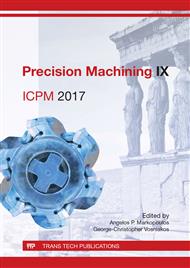[1]
P. Tamas, B. Illes: Process Improvement Trends for Manufacturing Systems in Industry 4. 0, Academic Journal of Manufacturing Engineering 14-4 (2016) 119-125.
Google Scholar
[2]
L. Dudás, M. Biró, L. L. Novák: Construction Modeling and Manufacturing Analysis of a New Rotary Combustion Engine, Intelligent Engineering Systems (INES), 2016 IEEE 20th Jubilee International Conference on. IEEE (2016) 89-94.
DOI: 10.1109/ines.2016.7555099
Google Scholar
[3]
P. Munoz-Escalona, P.G. Maropoulos, A geometrical model for surface roughness prediction when face milling Al 7075-T7351 with square insert tools, Journal of Manufacturing Systems 36 (2015) 216–223.
DOI: 10.1016/j.jmsy.2014.06.011
Google Scholar
[4]
N. Tamiloli, J. Venkatesan, B. Vijaya Ramnath, A grey-fuzzy modeling for evaluating surface roughness and material removal rate of coated end milling insert, Measurement 84 (2016) 68–82.
DOI: 10.1016/j.measurement.2016.02.008
Google Scholar
[5]
N. Liu, S.B. Wang, Y.F. Zhang, W.F. Lu, A novel approach to predicting surface roughness based on specific cutting energy consumption when slot milling Al-7075, International Journal of Mechanical Sciences 118 (2016) 13–20.
DOI: 10.1016/j.ijmecsci.2016.09.002
Google Scholar
[6]
S. Sheth, P.M. George, Experimental Investigation and Prediction of Flatness and Surface Roughness during Face Milling Operation of WCB Material, Procedia Technology 23 (2016) 344–351.
DOI: 10.1016/j.protcy.2016.03.036
Google Scholar
[7]
M. H. Ali, B. A. Khidhir, M.N.M. Ansari, B. Mohamed, FEM to predict the effect of feed rate on surface roughness with cutting force during face milling of titanium alloy, Housing and Building National Research Center (HBRC) Journal 9 (2013).
DOI: 10.1016/j.hbrcj.2013.05.003
Google Scholar
[8]
H. Hassanpour, M. H. Sadeghi, A. Rasti, S. Shajari, Investigation of surface roughness, microhardness and white layer thickness in hard milling of AISI 4340 using minimum quantity lubrication, Journal of Cleaner Production 120 (2016) 124–134.
DOI: 10.1016/j.jclepro.2015.12.091
Google Scholar
[9]
M. Hadad, M. Ramezani, Modeling and analysis of a novel approach in machining and structuring of flat surfaces using face milling process, International Journal of Machine Tools & Manufacture 105 (2016) 32–44.
DOI: 10.1016/j.ijmachtools.2016.03.005
Google Scholar
[10]
P. Michalik, J. Zajac, M. Hatala, D. Mital, V. Fecova, Monitoring surface roughness of thin-walled components from steel C45 machining down and up milling, Measurement 58 (2014) 416–428.
DOI: 10.1016/j.measurement.2014.09.008
Google Scholar
[11]
N. Masmiati, A.A.D. Sarhan, M.A.N. Hassan, M. Hamdi, Optimization of cutting conditions for minimum residual stress, cutting force and surface roughness in end milling of S50C medium carbon steel, Measurement 86 (2016) 253–265.
DOI: 10.1016/j.measurement.2016.02.049
Google Scholar
[12]
S. Wojciechowski, P. Twardowski, M. Pelic, R.W. Maruda, S. Barrans, G.M. Krolczyk, Precision surface characterization for finish cylindrical milling with dynamic tool displacements model, Precision Engineering 46 (2016) 158–165.
DOI: 10.1016/j.precisioneng.2016.04.010
Google Scholar
[13]
N.E. Karkalos, N.I. Galanis, A.P. Markopoulos: Surface roughness prediction for the milling of Ti–6Al–4V ELI alloy with the use of statistical and soft computing techniques, Measurement 90 (2016) 25–35.
DOI: 10.1016/j.measurement.2016.04.039
Google Scholar
[14]
I. Maňková, M. Vrabeľ, P. Kovac: Artificial neural network application for surface roughness prediction when drilling nickel based alloy. Manufacturing Technology, Vol. 13(2) (2013) 193–199.
DOI: 10.21062/ujep/x.2013/a/1213-2489/mt/13/2/193
Google Scholar
[15]
M. Kasina, K. Vasilko, Experimental Verification of the Relation between the Surface Roughness and the Type of Used Tool Coating. Manufacturing Technology 12 (2012) 27 – 30.
DOI: 10.21062/ujep/x.2012/a/1213-2489/mt/12/1/27
Google Scholar
[16]
J. Hricova, N. Naprstkova, Surface Roughness Optimization in Milling Aluminium Alloy by Using the Taguchi´s Design of Experiment. Manufacturing Technology 15-4 (2015) 541-546.
DOI: 10.21062/ujep/x.2015/a/1213-2489/mt/15/4/541
Google Scholar
[17]
C. Felho: Investigation of surface roughness in machining by single and multi-point tools, Ph.D. dissertation, Otto von Guericke University, Magdeburg, (2014).
Google Scholar
[18]
J. Kundrak: Increasing the effectiveness of machining by application of composite tools in boring of cylindrical and polygon surfaces, CSc Dissertation (in Russian), Tula, (1986).
Google Scholar
[19]
C. Felho, J. Kundrak: Effect of the Changing of the Feed on Surface Topography at Face Milling, International Journal of Mechanical Engineering 1 (2016) 114–121.
Google Scholar
[20]
C. Felho, B. Karpuschewski, J. Kundrak: Surface roughness modelling in face milling, Procedia CIRP 31 (2015) 136-141.
DOI: 10.1016/j.procir.2015.03.075
Google Scholar
[21]
B. Mikó, J. Beno, I. Mankova: Experimental Verification of Cusp Heights when 3D Milling Rounded Surfaces; Acta Polytechnica Hungarica, 9-6 (2012) 101-116.
DOI: 10.12700/aph.9.6.2012.6.7
Google Scholar


